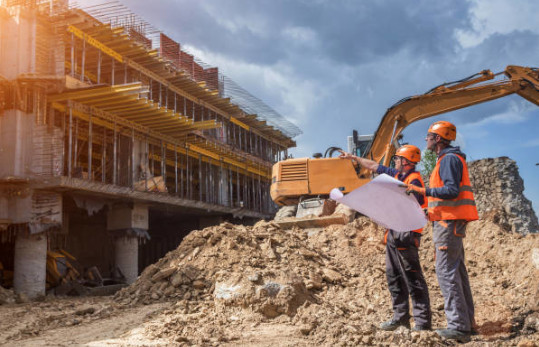Professional Civil Geotechnical Engineering Services for Intricate Projects
Professional Civil Geotechnical Engineering Services for Intricate Projects
Blog Article
Just How Consulting Engineers Enhance Geotechnical Design Projects: Insights Into Their Competence, Approaches, and Collaborative Approaches
Consulting engineers are pivotal in enhancing geotechnical engineering jobs, applying their specialized knowledge to navigate the intricacies of subsurface conditions. Their methodologies incorporate a series of website investigation methods, consisting of Standard Infiltration Tests (SPT) and Cone Infiltration Tests (CPT), which educate critical choices throughout the design and building phases. Furthermore, their joint approaches foster interaction among diverse task stakeholders, eventually shaping the task's trajectory. As we analyze the multifaceted duties these experts play, it ends up being clear that their payments prolong past technical experience, motivating a closer look at the implications for job success.
Function of Consulting Engineers
The proficiency of speaking with engineers in geotechnical design is basic to the successful execution of construction tasks. These experts play a critical function in analyzing dirt and rock homes, which are critical aspects influencing layout and construction choices. By carrying out thorough website examinations, getting in touch with engineers accumulate essential data that educates the style process, ensuring tasks are improved steady and appropriate ground.
Consulting designers also offer invaluable insights right into danger administration (geotechnical geologist). They recognize potential geotechnical hazards, such as landslides, soil liquefaction, and settlement concerns, enabling stakeholders to implement reliable reduction strategies. Their expertise help in enhancing structure designs, which can lead to substantial price savings and boosted safety
Additionally, consulting designers act as a crucial web link between job proprietors, designers, and contractors. Their capability to convert complex geotechnical data right into workable referrals fosters collaboration and assists in educated decision-making throughout the job lifecycle. This multidisciplinary method not only improves project effectiveness however also guarantees compliance with regulatory requirements and finest methods.
Key Methods in Geotechnical Engineering

One primary approach is website examination, which includes carrying out area examinations and laboratory evaluations to collect information on subsurface problems. Techniques such as Requirement Penetration Screening (SPT) and Cone Penetration Screening (CPT) are commonly used to examine dirt stratigraphy and stamina. Furthermore, geophysical techniques, consisting of seismic and electric resistivity surveys, provide non-invasive ways to evaluate subsurface features.
One more essential technique is numerical modeling, which enables designers to imitate different situations and forecast how soil-structure interactions will certainly behave under various loading problems. Limited Element Evaluation (FEA) is a common strategy used in this context.
Moreover, the style of structures, retaining frameworks, and earthworks counts greatly on these methodologies - geotechnical geologist. By incorporating innovative analytical tools with area data, getting in touch with designers can this establish customized services that attend to particular task challenges, ultimately contributing to the security and security of building projects
Value of Dirt Analysis
Dirt evaluation functions as a foundational aspect in geotechnical design, supplying important understandings into the physical and chemical residential properties of soil needed for effective building and construction preparation. Understanding soil features is crucial for identifying its load-bearing ability, drainage habits, and potential for negotiation or instability. Detailed soil investigations, consisting of sampling and lab screening, assistance recognize specifications such as soil type, wetness web content, density, and shear stamina.
These evaluations inform the option of appropriate building and construction strategies and products, ultimately affecting job security and long life. Cohesive dirts might call for various foundation layouts compared to granular dirts, demanding tailored design options. Dirt analysis help in recognizing contaminants that might position threats to human health and wellness or the atmosphere, enabling for the development of mitigation strategies.
Including dirt analysis into the onset of job development helps to reduce unexpected difficulties, ensuring that designers can prepare for and resolve potential issues before they rise. By establishing a detailed understanding of the website problems, consulting designers can maximize layout efficiency and lower prices, thus improving the overall success of geotechnical design tasks.
Joint Methods in Jobs
Effective geotechnical tasks typically depend upon collective methods that unite varied competence from various disciplines. Effective cooperation among getting in touch with engineers, geologists, ecological researchers, and construction specialists is important for resolving intricate difficulties and optimizing job end results. By leveraging the unique skills and expertise of each staff member, projects can gain right here from a holistic understanding of the site conditions, regulative demands, and engineering restrictions.
Normal interaction and interdisciplinary meetings facilitate the sharing of insights and cultivate a culture of teamwork. These joint initiatives allow the recognition of potential risks early in the project lifecycle, enabling for timely mitigation techniques. Integrating feedback from stakeholders, including neighborhood areas and governing companies, makes certain that all perspectives are thought about, boosting job acceptance and compliance.
Furthermore, the integration of sophisticated innovations, such as Geographic Information Solution (GIS) and Building Info Modeling (BIM), additional improves partnership. These tools permit the real-time sharing of information and visualization of geotechnical problems, check out this site promoting notified decision-making. Eventually, a collaborative method not only simplifies job implementation yet likewise lays the structure for innovative remedies to intricate geotechnical design obstacles.
Influence On Task End Results

Consulting engineers employ innovative methodologies such as risk analysis and predictive modeling, which improve the accuracy of job projections. Their ability to integrate cutting-edge modern technologies, like geotechnical instrumentation and information analytics, additionally improves the design and construction procedures. Because of this, tasks experience boosted effectiveness, minimized prices, and reduced delays.
Moreover, fostering reliable communication and partnership amongst group participants improves analytical capabilities. When difficulties occur, an unified front allows for speedy recognition of solutions, avoiding prospective setbacks. Ultimately, the collective efforts of consulting engineers add to greater high quality outcomes, making sure that tasks fulfill both governing standards and client expectations.
Final Thought

Report this page